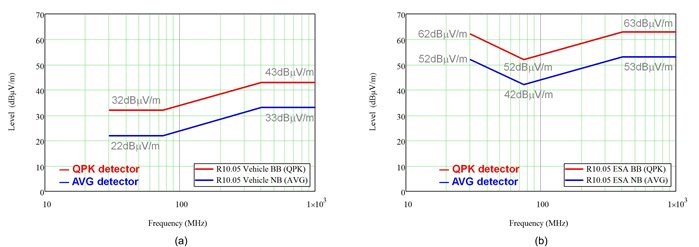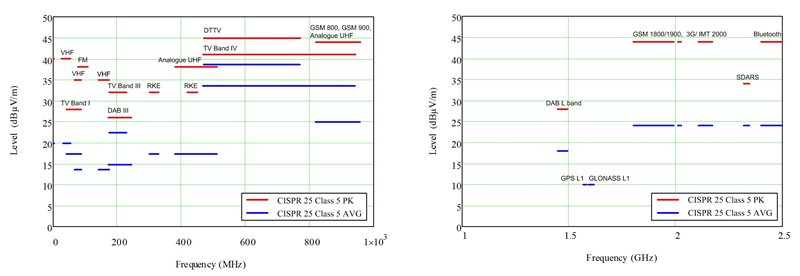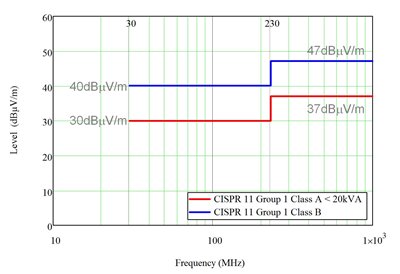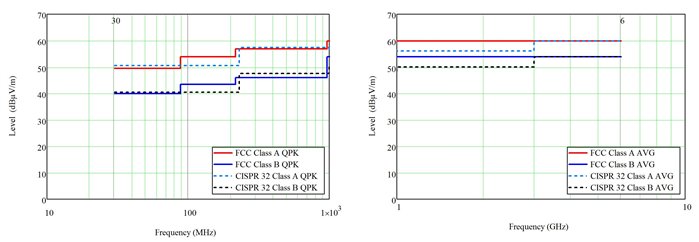SSZT671 july 2018 LM25145 , LM5145 , LM53635-Q1 , LMR33620 , LMR33630 , LMR36006 , LMR36015
Radiated electromagnetic interference (EMI) from switching power supplies is dynamic and situational problem that relates to circuit board layout, component placement and parasitic effects within the power supply itself, as well as the overall system in which it operates. As such, the issue is quite challenging from the system designer’s perspective, and an understanding of radiated EMI measurement requirements, frequency ranges and applicable limits is important.
Having reviewed the relevant standards for conducted EMI in part 1, part 2 of this Power House blog post series provides an overview of radiated EMI standards. Table 1 from part 1 provides a list of relevant abbreviations that are applicable here as well.
EMI Standards for Automotive
Assessing EMI performance in automotive applications is an issue of increasing concern for end-system designers involved in automotive design and testing. Tracking all possible interactions that might result in a radiated EMI problem is a challenge, particularly given the relatively small volume within a vehicle’s wiring harness characterized by densely packed arrangements of power and signal runs.
From a regulatory standpoint, United Nations Economic Commission for Europe (UNECE) Regulation 10 (R10.05) requires that manufacturers gain type approval for all vehicles, electronic subassemblies (ESAs), components and separate technical units (STUs). Even though this regulation emanates from Europe, it has broader relevance for other geographies, as automotive manufacturing is a global business. Figure 1 provides limits for broadband (BB) and narrowband (NB) radiated emissions over the applicable frequency range of 30MHz to 1GHz when measured using Comité International Spécial des Perturbations Radioélectriques (CISPR) 16-defined quasi-peak (QPK) and average (AVG) detectors, respectively.
 Figure 1 UNECE Regulation 10 Radiated
EMI Limits for Vehicles at 10m (a); ESAs/components at 1m (b)
Figure 1 UNECE Regulation 10 Radiated
EMI Limits for Vehicles at 10m (a); ESAs/components at 1m (b)R10.05 refers extensively to CISPR 12 and CISPR 25, which are international standards containing limits and procedures for the measurement of radio disturbances to protect off-board and on-board receivers, respectively. CISPR 12 protects radio reception away from the vehicle and is a whole vehicle test rather than applying to subassemblies or components, whereas CISPR 25 protects radio reception in the vehicle and therefore has limit classes defined in bands for various radio services. It includes both module/component emissions measurements, as well as whole vehicle emissions tests using the antenna provided with the vehicle.
Figure 2 shows the Class 5 radiated emission limits using peak (PK) and AVG detectors for components/modules measured over a frequency range of 150kHz to 2.5GHz in a shielded enclosure. Measurements are pertinent to receivers within the vehicle operating in the broadcast and mobile service bands.
 Figure 2 CISPR 25 Class 5 Radiated
Emission Limits for Components/modules
Figure 2 CISPR 25 Class 5 Radiated
Emission Limits for Components/modulesTable 1 shows the antenna recommendations for various frequency ranges and the required measurement polarization. The biconical and log-periodic antenna overlap in frequency capability, whereas a broadband antenna covers the cumulative of their frequency ranges.
| Frequency range | Antenna | Measurement polarization |
|---|---|---|
| 150kHz to 30MHz | 1m vertical monopole with counterpoise | Vertical only |
| 30MHz to 300MHz | Biconical | Horizontal and vertical |
| 200MHz to 1GHz | Log-periodic | |
| 30MHz to 1GHz | Broadband (bilog) | |
| 1GHz to 2.5GHz | Horn or log-periodic |
EMI Standards for Industrial Equipment
CISPR 11 is the international product standard for EMI disturbances from industrial, scientific and medical (ISM) radio-frequency (RF) equipment. CISPR 11 applies to a wide variety of applications, including wireless power transfer (WPT) charging equipment, microwave cooking appliances, Wi-Fi® systems and arc welders.
Equipment in Groups 1 and 2 is delineated with scope for general-purpose and RF-specific applications, respectively. Group 1 contains all ISM equipment in which there is intentionally generated and/or conductively coupled RF energy that is necessary for the internal functioning of the equipment itself. Group 2 contains all ISM equipment in which RF energy is intentionally generated and/or used for material inspection, analysis or treatment.
Figure 3 provides CISPR 11 radiated limits for Group 1 equipment. Class A equipment is for use in all establishments other than domestic and is measured on a test site or in situ; Class B covers domestic and is measured only on a test site. I encourage you to review CISPR 11 to understand the unique specification limits and test setups for the various equipment groups and classes.
 Figure 3 CISPR 11/EN 55011 Group 1
Radiated Emission Limits Using a QPK Detector and Measured on a Test Site with a
10m Antenna Distance
Figure 3 CISPR 11/EN 55011 Group 1
Radiated Emission Limits Using a QPK Detector and Measured on a Test Site with a
10m Antenna DistanceNote that certain industrial end equipment may have dedicated system-level standards that direct EMI tests by referencing CISPR 11. For instance, International Electrotechnical Commission (IEC) 62040-2 provides EMC requirements for uninterruptible power systems (UPSs) that deliver output voltages not exceeding 1500VDC or 1000VAC. Another system-level standard, IEC 61800-3, dictates emission requirements and specific test methods for adjustable-speed motor-drive systems.
EMI Standards for Multimedia Equipment
CISPR 22/European Norms (EN) 55022, the well-known standard for power-supply products used in information technology equipment (ITE) with a supply voltage not exceeding 600V, was recently subsumed into CISPR 32/EN 55032, creating a new product family standard for multimedia equipment (MME). Meanwhile, products designed for North American markets have complied with limits set by Section 15.109 of the Federal Communications Commission (FCC) Part 15 Subpart B for unintentional radiators.
For an antenna measurement distance of 3m, Figure 4a plots the Class A and Class B limit lines when using a QPK detector for frequencies below 1GHz. Figure 4b plots the equivalent limits above 1GHz using an AVG detector. In addition, the measuring receiver bandwidth (RBW) is set at 120kHz and 1MHz, respectively, for frequencies below and above 1GHz. Class B limits for residential or domestic applications are lower by 6dB to 10dB than Class A limits for commercial use.
 Figure 4 FCC Part 15 and CISPR 22/32
Radiated Limits for Class a and Class B
Figure 4 FCC Part 15 and CISPR 22/32
Radiated Limits for Class a and Class BSummary
Radiated EMI is an increasingly challenging topic for power converters with high dv/dt and di/dt switching waveforms. Numerous governing bodies regulate the permissible levels of radiated emissions generated by an end product, and an understanding of the EMI standards pertaining to the application is essential.
Additional Resources
- Read the article series, “The engineer’s guide to EMI in DC/DC converters.”
- Take the EMI training webinar, “Automotive EMI reduction techniques, applications and solutions.”
- Order the EMI-optimized evaluation module for the 60V, 1.5A LMR36015 buck converter in the HotRodTM package.
- Examine the radiated EMI results provided with these reference designs from the TI Designs library:
- Download the white paper, “An overview of radiated EMI specifications for power supplies.”